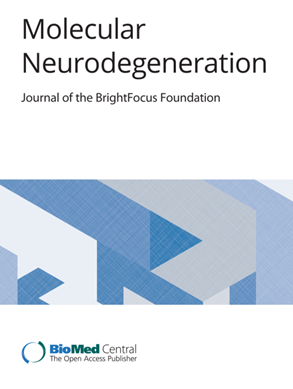在老年小鼠中,与阿尔茨海默病相关的UNC5C T835M突变导致涉及氧化应激和海马萎缩的神经变性
IF 17.5
1区 医学
Q1 NEUROSCIENCES
引用次数: 0
摘要
阿尔茨海默病(AD)的特征是淀粉样斑块、神经原纤维缠结、突触和神经元丧失。最近,一种罕见的常染色体显性编码突变,T835M,在uncoordinated 5c (UNC5C) netrin受体基因中,与晚发性AD (LOAD)分离。原代海马神经元中T835M的过表达增加了对包括β -淀粉样蛋白(a β)在内的神经毒性刺激的细胞死亡,这表明T835M可能导致LOAD风险增加的机制。然而,t835m介导的细胞死亡的分子机制尚不清楚。为此,我们建立小鼠T835M敲入(Unc5cKI/KI)模型,通过生化和组织学分析了解T835M介导的晚发性阿尔茨海默病发病的分子机制。我们发现,纯合子KI小鼠在12-18月龄时,海马体积显著减少,心室体积增加,树突状组织(CA1区)紊乱,UNC5C蛋白水平降低。此外,通过TUNEL分析和激活Caspase 3/7实验,我们发现Unc5cKI/KI小鼠在12月龄时观察到神经元细胞死亡。海马样品的蛋白质组学分析显示,在18个月时,氧化应激上调,伴侣蛋白下调,证实了生化和组织学结果,即c-Jun n -末端激酶(JNK)磷酸化、NADPH氧化酶升高,Netrin1水平降低。此外,Unc5cKI/KI小鼠星形胶质细胞也表现出形态学变化,分支过程数量增加,GFAP水平降低,小胶质细胞活化明显增加。总之,这些结果表明,T835M突变通过创造氧化应激环境导致突触变性和星形胶质细胞减弱,从而通过凋亡导致神经元细胞死亡,从而导致神经退行性变。此外,为了评估淀粉样蛋白病理对突变的影响,我们将Unc5cKI/KI小鼠与AppNL - G - F/NL - G - F小鼠杂交,观察到突变相关的变化随着Aβ42水平的升高而加剧,这表明T835M突变增加了神经元对细胞死亡的易感性和Aβ42水平的升高,从而促进了AD的发病。了解海马等神经退行性变易感区域细胞死亡的分子机制,可以揭示阿尔茨海默病发病过程中参与细胞死亡的因素和途径,从而为阿尔茨海默病的治疗提供信息。本文章由计算机程序翻译,如有差异,请以英文原文为准。
The UNC5C T835M mutation associated with Alzheimer’s disease leads to neurodegeneration involving oxidative stress and hippocampal atrophy in aged mice
Alzheimer’s disease (AD) is characterized by amyloid plaques, neurofibrillary tangles, and synaptic and neuronal loss. Recently, a rare autosomal dominant coding mutation, T835M, in the Un-coordinated 5c (UNC5C) netrin receptor gene was segregated with late-onset AD (LOAD). Overexpression of T835M in primary hippocampal neurons increased cell death in response to neurotoxic stimuli including beta-amyloid (Aβ) suggesting a mechanism by which T835M may confer increased risk of LOAD. However, the molecular mechanism of T835M-mediated cell death remained under explored. Toward this end, we generated a mouse T835M knock-in (Unc5cKI/KI) model and employed biochemical and histological analyses to understand the molecular mechanism of T835M-mediated pathogenesis in late onset Alzheimer's disease. We show that homozygous KI mice have significantly reduced hippocampal volume, increased ventricular volume, dendritic disorganization (CA1 region) and reduced UNC5C protein level by 12–18 months of age. Further, we show that the neuronal cell death is observed in the Unc5cKI/KI mice by 12 months of age by TUNEL analysis and activated Caspase 3/7 assay. Proteomic analysis of hippocampal samples showed upregulation of oxidative stress and downregulation of chaperone proteins at 18 months corroborating the biochemical and histological results showing increased c-Jun N-terminal Kinase (JNK) phosphorylation, NADPH oxidase, and decreased Netrin1 levels. Moreover, Unc5cKI/KI mice also show morphological changes in the astrocytes with increased number of branched processes, reduced GFAP levels, and significantly increased activation of microglia. Overall, these results suggest that T835M mutation causes neurodegeneration by creating an oxidative stress environment leading to synaptic degeneration and weakened astrocytes, thereby leading to neuronal cell death via apoptosis. Furthermore, to assess the effects of amyloid pathology on the mutation, we crossed Unc5cKI/KI mice with AppNL−G−F/NL−G−F mice and observed an exacerbation of mutation-associated changes along with increased levels of Aβ42, suggesting that the T835M mutation increases the susceptibility of neurons to cell death and elevated Aβ42 levels, thus promoting AD pathogenesis. Understanding the molecular mechanism of cell death in regions susceptible to neurodegeneration such as the hippocampus could shed light on the players and pathways involved in cell death in AD pathogenesis and therefore could inform therapeutic approaches for AD.
求助全文
通过发布文献求助,成功后即可免费获取论文全文。
去求助
来源期刊

Molecular Neurodegeneration
医学-神经科学
CiteScore
23.00
自引率
4.60%
发文量
78
审稿时长
6-12 weeks
期刊介绍:
Molecular Neurodegeneration, an open-access, peer-reviewed journal, comprehensively covers neurodegeneration research at the molecular and cellular levels.
Neurodegenerative diseases, such as Alzheimer's, Parkinson's, Huntington's, and prion diseases, fall under its purview. These disorders, often linked to advanced aging and characterized by varying degrees of dementia, pose a significant public health concern with the growing aging population. Recent strides in understanding the molecular and cellular mechanisms of these neurodegenerative disorders offer valuable insights into their pathogenesis.
 求助内容:
求助内容: 应助结果提醒方式:
应助结果提醒方式:


